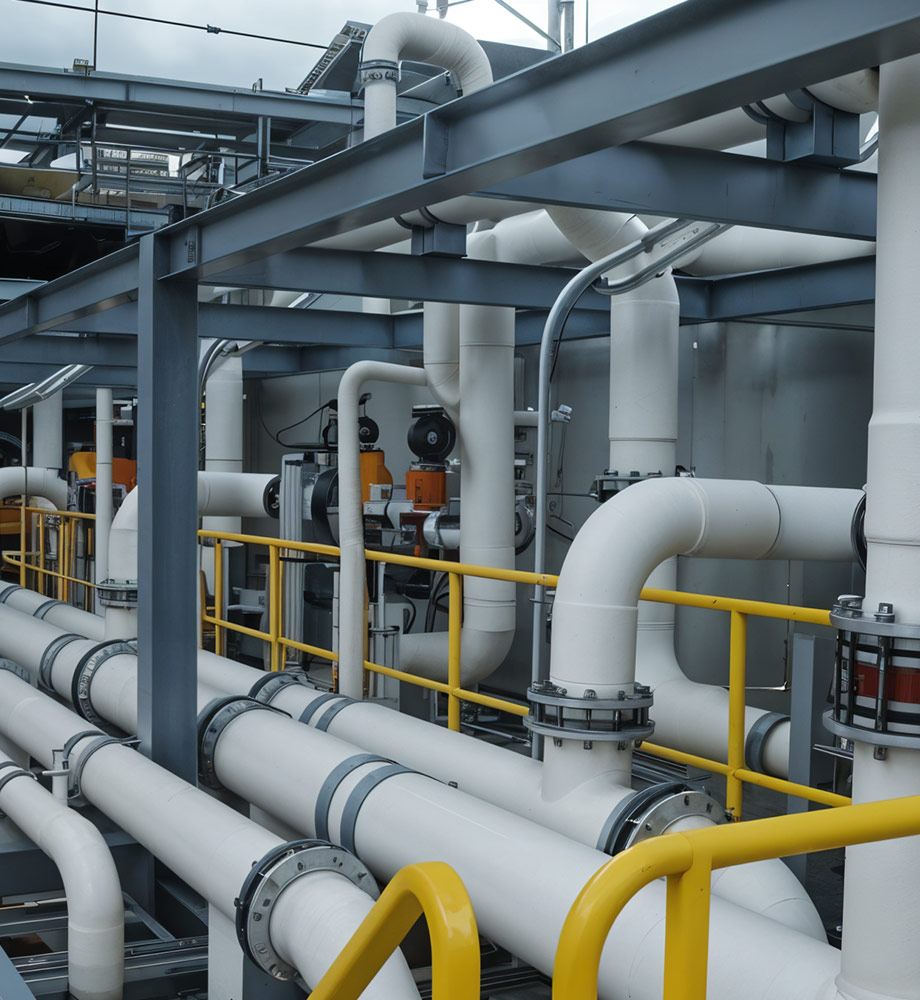Key Features
- High Corrosion Resistance: No rust or chemical erosion in aggressive sewage or chemical pipelines. Resists H₂S, chlorides, and disinfectants.
- Wide Size Range: Available in diameters from a few inches up to 4 meters, accommodating small drains to large transfer lines.
- Pressure Ratings to 60 bar: Standard FRP pipes handle pressures up to ~60 bar (GRE designs much higher, if needed), covering all but the most extreme pump lines.
- Smooth, Rigid Interior: Laminate construction yields a smooth bore (Hazen C-150), minimizing head loss. Surface remains smooth over lifetime (no scaling).
- All Fittings Available: Full range of FRP molded or filament-wound bends, reducers, tees, flanges, and ductile iron flange adapters can be supplied to create complete systems.
- Conductive or Non-Conductive Options: Inner conductive layers can be added per safety requirements, or entirely non-conductive for electrical isolation.
Benefits
- Long Life / Low Maintenance: FRP pipes last decades in wastewater service without corrosion or scale build-up; joints do not leak, eliminating costly repair work.
- Light Weight and Flexible Handling: Weighs only ~1/5 of steel by volume; large lengths can be handled by two workers, speeding installation.
- Prefabrication: Pipes can be factory-spooled or pre-welded into large sections, reducing on-site joints and installation time.
- Electrical Insulation: Non-conductive material adds safety; no galvanic corrosion issues with dissimilar metals.
- Fire Safety: FRP can be formulated with flame retardants; in any case it does not support growth of combustion like wood.
- Smooth Hydraulic Performance: High flow capacity lowers pumping energy costs over the system’s life.
Applications
- Sewage Collection and Transfer Lines: In-plant piping between basins, clarifiers, digesters, and outfalls.
- Chemical Dosing Piping: For acids, alkalis, chlorine and polymer feeds in STP processes.
- Sludge Pipes: Acidic sludge return, scum removal, and decanted water return lines.
- Effluent Channels: GRP troughs and pipes for final effluent conveyance to discharge.
- Plant Utilities: Cross-connections to boilers, cooling towers, or water recycling loops where corrosion is a concern.
Technical Specifications
- Standards: Fabricated to DIN, BS, ASTM, AWWA, IS, JIS etc., as required.
- Material Grades: Standard resins include isophthalic/polyester for general service, vinyl ester or epoxy for higher chemical load. Fitting glass content ≥25–35%.
- Jointing Methods: Flange joints (FRP/steel flanges), bell-and-spigot with adhesive, mechanical couplings, or flange adapters.
- Pressure / Temperature: Custom designed; typical ranges 150–500 psi (10–35 bar), up to ~80°C (or more with special resin). GRE piping can go much higher (hundreds of bar).
- Coatings / Liners: For extreme service, internal thermoplastic liners (HDPE, etc.) can be applied to FRP pipe (dual laminate), or FRP can be overwrapped on steel.
- Fire Protection: Polyurethane foam insulation (Thermoshield) or intumescent paints optional for high-temperature or fire-risk applications.
Unique Selling Points (USPs)
- Largest Fabrication Capacity: We can deliver pipes up to 4000 mm diameter and pressurized GRE lines up to 400+ bar.
- Full System Scope: Includes supports, expansion joints, bending analysis and installation services – a complete piping solution.
- Specialty Chemical Compatibility: We maintain an in-house library of chemical resistance data to specify the perfect resin/liner combination for any effluent.
- Rapid Lead Times: In-house workshops and supply chain allow faster turnaround than competitors.
- Expertise in STP Work: Decades of projects in wastewater, providing insight into layout optimization and longevity.

